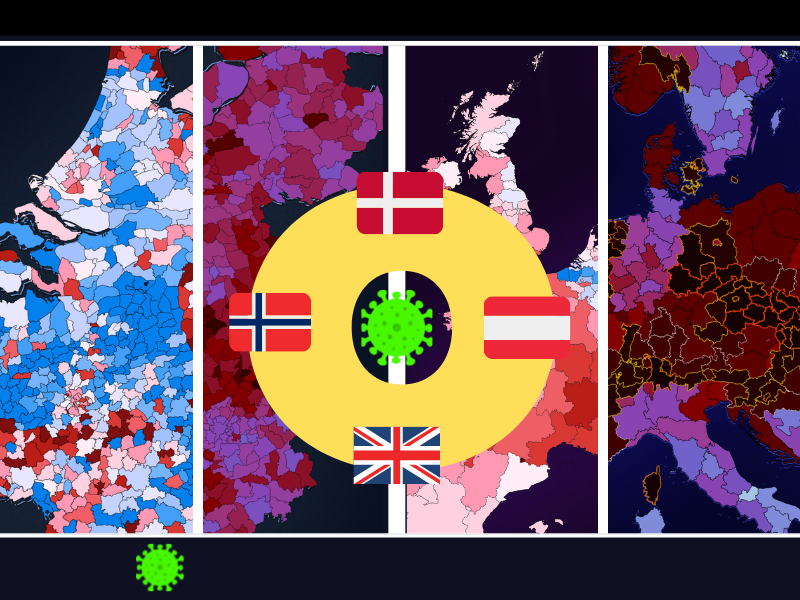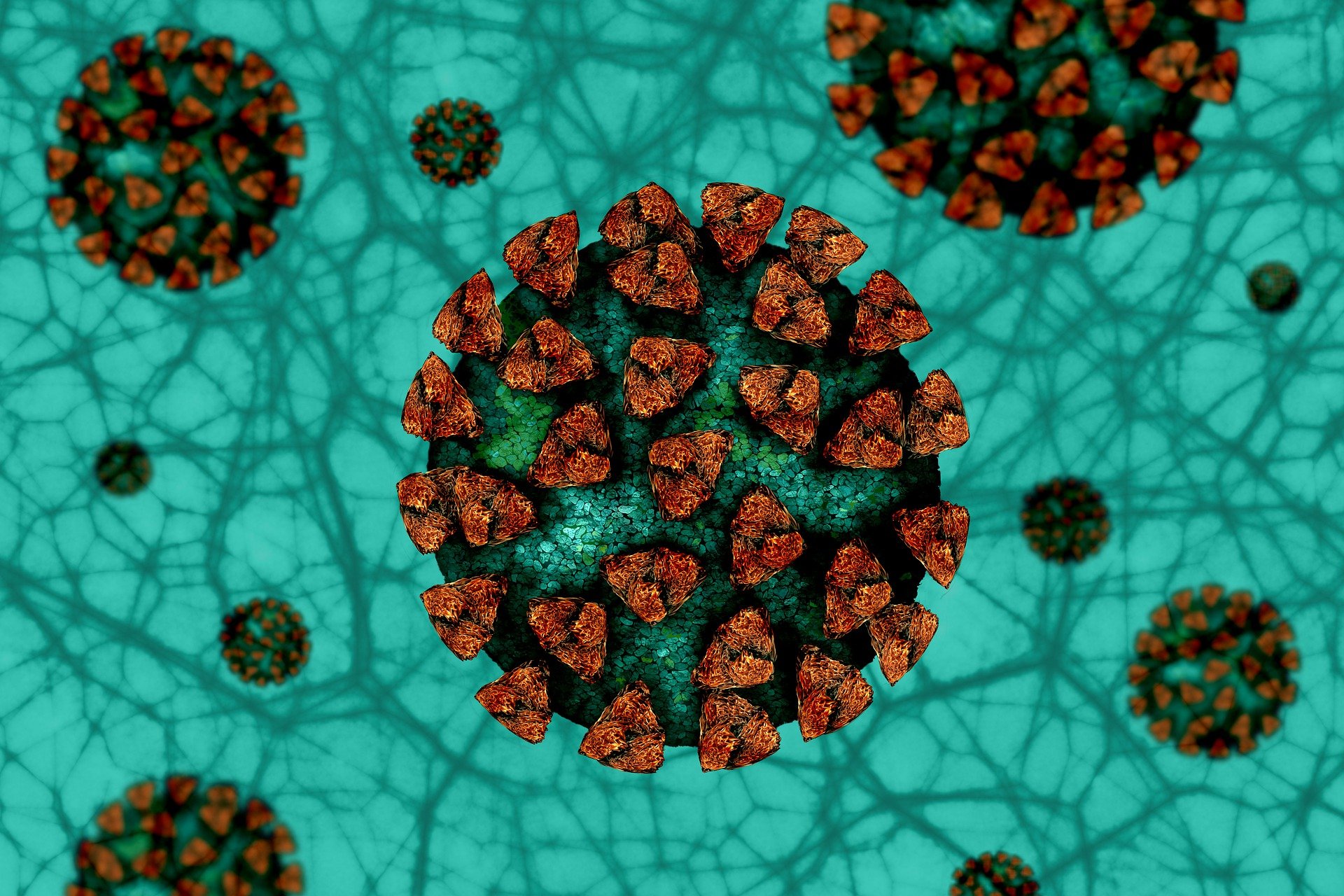
It is highly likely that we will very soon be rid of the Delta variant that is currently gripping Europe. But don’t be too quick to jump for joy, as the next dark cloud is already gathering. We don’t know very much about its successor Omicron. But this will doubtlessly change in the very near future since it is even more contagious than the previous SARS2-nCoV viruses.
Because even without a newly mutated Covid-19, a lot of countries are up to their necks in trouble. After a gruelling November month, the peak seems to be over for now in Austria, Slovenia, Croatia and Hungary. However, for Switzerland, Norway, France and Denmark, there are still a few challenging weeks ahead. The rates for the Low Countries have fallen slightly compared to last week, but together with the Czech Republic and Slovakia, they still remain the ‘baddest’ boys in the class.
These are the figures from December 2-8 at the sub-national level. This week’s slider chart shows the difference from three weeks ago.

Fewer infections or not enough testing?
Although the Low Countries have been among the continental leaders in terms of corona contagions since early last November, so far the situation in the hospitals has not been as severe as elsewhere in Europe in recent weeks. Has Code Black been averted? That remains to be seen. Despite the fact that an increasing number of patients are being sent home with oxygen tanks and help from Germany, the pressure remains as high as ever.
Things are looking a little rosier for the Belgians. Infection rates are stagnating, while the pressure on hospitals is easing off. Over the next three weeks, a longer Christmas vacation, more remote education for high school students, a compulsory use of face masks for children as young as 6, and an earlier closure of the hospitality industry at 11 pm should bring the figures back to acceptable values.
According to the federal government, the risk of life-threatening symptoms from corona has been greatly reduced thanks to the vaccination coverage and the proactive booster policy that provides optimal protection for those most vulnerable. On the slider chart below, the weekly figures from December 3 to 9 are laid out beside those from two weeks ago. Slightly lighter colors across the board. However, in the Netherlands this may also be due to the faltering testing capacity.
Rising or falling?
The slider charts offer very good insight into the number of infections per capita. Yet this trend can be visualized even more clearly. In the blue municipalities, the number of infections was higher between 26 November and 2 December than between 3 and 9 December. This in itself also makes sense because of the new measures. But the adjacent red areas prove that this is by no means the case everywhere….

Week versus week
Are the measures yielding results? Is this the “staying-at-home effect”? Maybe so. In any case, the largest drop was seen in Overijssel. Yet the number of new corona cases is also rising sharply in other regions, such as around Utrecht, Eindhoven and in the top of North Holland. The exact cause of this departure from the trend is notes clear.
In Denmark and Norway however, government authorities issued a stern warning about a similar rapid Covid advance around Copenhagen and Oslo: Omicron. Whether this also explains the increases in North Holland, Eindhoven, France and Switzerland is also not known. The Scandinavian countries have their virus-sampling pretty well organized, so they are able to find these things out relatively quickly.
The odds are that increases elsewhere are “just” attributable to Delta, which, after all, can also still spread rapidly and fiercely.

Scandinavian storm surge
Denmark and Norway are not really known as countries that have made a mess of things during the corona crisis. Nevertheless, both countries have tightened the rules. Danish schools are switching entirely to homeschooling, “unseated gatherings” with more than fifty people are prohibited, and the last round for nightspots in the hospital sector has been brought forward to just before midnight starting this week.
A crucial role here is reserved for the very large testing capacity that has already proven itself several times over. Despite the autumn peak, only about 1 % of the tests of Danes turned out to be positive. Because this means that it is possible to track the spread of the virus, their renowned track-and-trace research can effectively stamp out most of the outbreaks without the need for heavy-handed measures.
The fact that a lot of Omikron has been spotted here of all places should come as no surprise. The Statens Serum Institute also has an enormous capacity for sampling virus variants, which means that potential new variants can be discovered more quickly. The Danes have always kept corona under control relatively well by deploying as many slices of the Swiss cheese model as possible: Prevention is better than cure.

Emphatic advice or hard legislation?
A little further north, things went badly wrong at a Christmas party in Oslo last week, where as many as 70 % of the visitors tested positive for the new variant. A salient detail: they were fully vaccinated. Although none of them developed serious problems, the many breakthrough infections prove that two shots will most likely no longer provide adequate protection.
Partly as a result of this superspread event, the Norwegian government has ‘considerably’ tightened the reins for the capital region: No more alcohol after midnight and the number of visitors is limited to less than ten. Draconian corona policies have never really been introduced here. With flexible interventions on a regional level, whereby emphatic advice is preferred to hard legislation, the sparsely populated country has withstood all the corona waves without major problems so far.
Whether this appeal to personal accountability will also prevent the Norwegians from getting knocked flat by these steep corona surges will become clear in the coming weeks. Still, even at this point, there is still no real acute crisis here. Where then? The heat map with the weekly figures from August provides a pretty good idea. Sharp rises or rapid drops can be recognized immediately by the large differences in color in a short period of time.
Austrian coop up duty
After a disastrous November month with record peaks, nowhere else did the figures fall as fast as in Austria this week. How? Quite understandable. A whole swathe of repressive measures. The country opted for a full three-week lockdown in late November. Region by region and with very cautious steps, from Friday 10 December onwards, some easing is in the offing.
The strict policy in Austria was not only intended as a means to relieve the pressure on the healthcare system. The government is hoping to save the upcoming winter sports season with this. Nevertheless, skiing vacations in the Alpine country are only possible for those who meet the strict entry requirements and have no problem with the many rules during their stay, including an unconditional après-ski ban.
Incidentally, little will change for unvaccinated people after this weekend. Because of the national 2G policy, a full vaccination or proof of recovery is required in, among others, hair salons, retail and hospitality establishments, gyms, amusement parks and ski lifts. Partly for this reason, hundreds of thousands of residents got themselves vaccinated after all. Despite this, the vaccination rate lags behind that of most Western European countries by a few percentage points.
At the same time, the booster campaign is doing extremely well. On 8 December, around 28.6 % of Austrians had been jabbed for the third time. A percentage that the Netherlands can only dream of. Curious about which countries will be top contenders at the European Booster Championship? Take a look at the race of nations animation below showing the very latest data.
British booster bastion
At the beginning of December, almost a third of all Brits have already received a booster in their upper arms, making them the continental leader after Iceland. The NHS has been working at full capacity since September to ensure that as many people as possible get through the winter with optimum protection. This should prevent hospitals from buckling under the pressure while ensuring that society does not have to lock down. Is it working? Against Delta, well, at least in part.
The heat map earlier in this edition shows that Great Britain has been above average in terms of infections for months. Yet things are not getting out of hand over there as much as they are in Central Europe. This does not mean that all is quiet in hospitals or that no one is dying there anymore. But it is considerably less than in the Netherlands or Germany, if we are to believe the mortality figures.
Oh, oh, Omikron
A society with as few corona rules as possible is an absolute top priority in the United Kingdom of Boris Johnson. This autumn, it was only possible in very few places to catch a festival without a care in the world that did not have any social distancing rules, capacity restrictions, entry tests, early closing times, mouth/nose-coverings or require proof of vaccination.
The rapid booster campaign is aimed at preventing the need for further measures. The Achilles’ heel of this approach is easy to guess: Omicron. That’s why even the freedom-loving islanders were faced with new Covid restrictions this week. Total lockdown? Mwaah.
As of Friday, 10 December, face masks are returning to public indoor areas, hefty fines are in order for breaking quarantine regulations, and the so-called NHS Health Pass will become mandatory in nightlife and at major events. Will this go as far as it does in Austria? Not quite. The ‘tightened’ access policy in UK is broadly in line with the Dutch CoronaCheck of late September to early October.
That Omicron variant appears to be reshuffling the rules of the game against this already long-running pandemic is now a foregone conclusion. In any case, we will soon be rid of that nasty Delta variant. We are gradually getting to know its more contagious vaccine-defying successor. Specific details on how it is destroying our hopeful expectations for 2022 will follow very soon.








